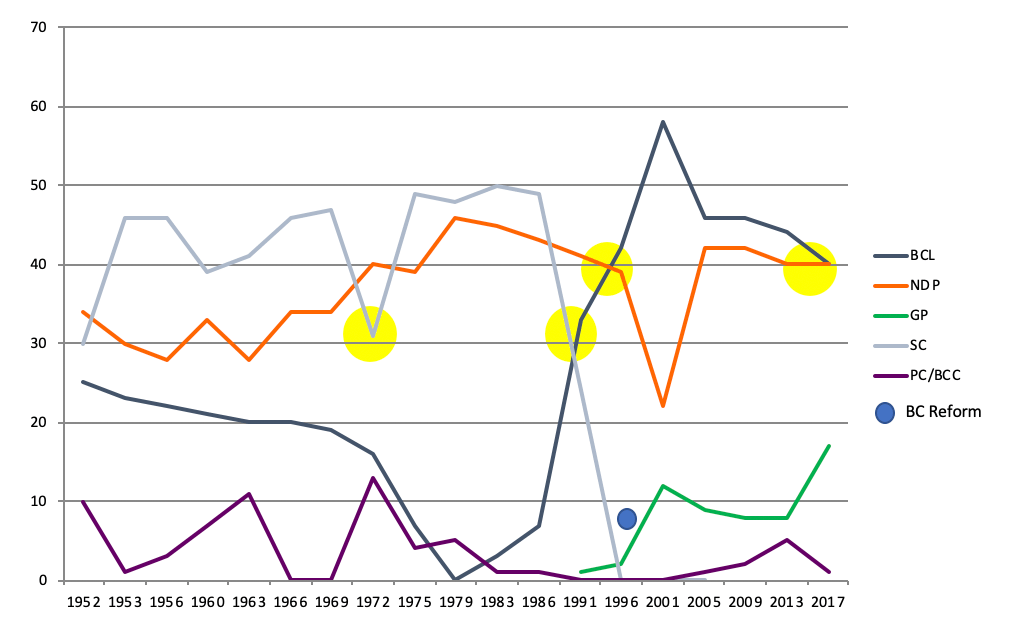Free enterprise coalitions usually win in BC. Electing a left-wing government has proven very hard over the last 80 years.
Since 1941, when the Liberals and Conservatives formed a war-time coalition to govern, it’s largely been a question of the NDP (and its predecessor, the CCF) contending against the leading free enterprise party or coalition in a bruising, polarizing battle. The scorecard is: Free Enterprise 17, CCF/NDP 4.*
Starting in 1952, the new de facto coalition was the Social Credit Party when it emerged from a four-way race to gain power and hold it for 20 years under the premiership of W.A.C. Bennett. In 1991, after winning 11 of 12 elections, the Socreds were dealt a mortal blow and were, subsequently, eclipsed by the BC Liberals who would evolve into the modern-day free enterprise contender. In this transitional period in the 1990s, the NDP won back-to-back majority governments.

The yellow circles note the times that the NDP won elections (1972, 1991, 1996) or took power (2017). In the first three, there was a significant vote split on the centre-right:
- 1972: an uptick of BC Conservatives eroded Socred support. The Socreds won in 1975 by remaking its coalition, jumping from 31% to 49% of the popular vote, defeating Dave Barrett’s NDP which basically held its 1972 vote at around 39-40%.
- 1991: the demise of the Socreds and simultaneous rise of the BC Liberals created a vote split that helped Mike Harcourt’s NDP win a majority.
- 1996: the upstart BC Reform Party cut into BC Liberal support, helping Glen Clark’s NDP win a majority, despite losing the popular vote.
- 2017: this was the first time the NDP gained power in BC without a significant centre-right vote-split across the province. While some BC Liberal voters (especially in Metro Vancouver) migrated to the Greens as the only alternative to the NDP, it was a single BC Conservative candidate in Courtenay-Comox that struck the decisive blow, taking over 7.5% in a riding the NDP won by only 189 votes.
When the NDP wins, it has some help, and sometimes that help is because of a tired government on its last legs. NDP ascension to power in 1972, 1991, and 2017 came after spending prolonged stretches as Official Opposition.
John Horgan is trying to make history in this election by being the first sitting NDP premier to serve a term of government and win a majority government. He enters the election enjoying high poll standings unfamiliar to his predecessors, and hopes to win BC Liberal votes outright rather than relying on a vote split. By winning a plurality of the popular vote and winning a majority of seats, it would be a historic win for the NDP, given the historical scorecard.
From the BC Liberal standpoint, it has entered an election as main contender in the six past elections, having won a majority four times, and winning the popular vote the other two times (when it did not ultimately form a government). It has been a successful big-tent free enterprise party in the modern era.
The question now is: Can the NDP sustain its pre-election lead in the polls? Alternatively, can the BC Liberals galvanize supporters and consolidate the free enterprise vote as it has done since 1996? Other than the 2001 election, every election in the past 50 years has been a hard-fought battle where the outcome was never entirely certain at the outset of the campaign. We are used to tough fights and a simple cruise to victory would go against the grain of BC politics.
*Scorecard: Free enterprise 1945, 1949, 1952, 1953, 1956, 1960, 1963, 1966, 1969, 1975, 1979, 1983, 1986, 2001, 2005, 2009, 2013; CCF/NDP 1972, 1991, 1996, 2017 (gained power)
BC political histories on rosedeer.blog:
Perhaps the old “free enterprise party” is no longer a big enough tent. Christy didn’t look to care for people left behind in the economy.
LikeLike